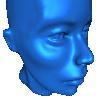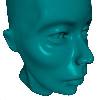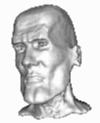Volume Graphics Gallery |
| This page contains images and brief descriptions of
recent volumetric models created with the volume sculpting
system that is being developed by Ph.D. student Andreas
Bærentzen.
Except where mentioned all images are created with rendering facilities incorporated in the sculpting system. |
| The images below show the same view of a model portraying the head of a (Disneyesque) bear. The leftmost image was generated by rendering a point cloud approximating the head. The centre image is also a point cloud, but this time the points are slightly larger which makes them cover the surface. Finally the image on the right is ray traced. The bear is available here in raw format suitable for the NVidia multitexture demo maintained by Klaus Engel from the University of Stuttgart,Visualization and Interactive Systems Group. |
   |
|
Maintained by: Andreas Bærentzen, jab 'at' imm.dtu.dk Last modified: Thu Sep 27 14:25:00 CEST 2001 |








